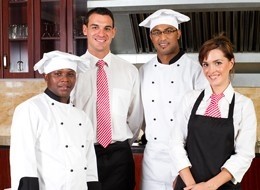Restaurant Safety Hazards

It is critical that all levels of employees in a restaurant --- from the manager to the servers --- educate themselves about the various safety hazards in order to prevent injury, and also to prevent such issues as litigation and insurance claims.
Electric Hazards
A number of electric hazards can be found in a restaurant, including worn out cords, faulty wiring, receptacles that are damaged and bad equipment. Employers can address these hazards by educating employees about their presence and how to appropriately deal with them (including shutting off the current before aiding someone who has been shocked as well as encouraging training in CPR). Employers should also make sure that all equipment is properly maintained.
Fire Hazards
The threat of fire is one of the most common hazards to haunt any restaurant. Restaurant fires can be caused in numerous ways, including inadequate housekeeping measures, grease traps that remain full (thus increasing the likelihood of a grease fire), flammable materials not stored properly and inadequate maintenance of electrical cords. Employers and employees can mitigate these hazards by installing and learning to properly use fire extinguishers and formulating appropriate evacuation plans (including designating and maintaining fire exits and educating employees about those exits).
Slips and Falls
Another common hazard found in restaurants are the occurrence of slips and falls which, though seemingly minor, can cause a great deal of injury in some instances. One of the chief causes of this hazard is clutter or wet floors, so it is necessary that employers and employees ensure that appropriate signs are present when the floors are wet and that floors stay free of clutter. This is especially important for exits, as these should be kept clear at all times. Employers should also encourage employees to wear appropriate footwear, ensure that floors are in good repair (with no uneven surfaces), and provide adequate lighting in all work areas.
Other Hazards
Working in a restaurant often requires carrying hot plates and beverage containers, and this frequently leads to burns, both to employees and to customers. Employees should use trays or pads to carry hot plates and should ensure that they are adequately trained in the use of the hot beverage equipment. Never put your hand near where hot liquids emerge; if you are preparing coffee, make sure you wait until it is finished brewing before taking away the pot. Warn customers of hot plates or mugs.
Electric Hazards
A number of electric hazards can be found in a restaurant, including worn out cords, faulty wiring, receptacles that are damaged and bad equipment. Employers can address these hazards by educating employees about their presence and how to appropriately deal with them (including shutting off the current before aiding someone who has been shocked as well as encouraging training in CPR). Employers should also make sure that all equipment is properly maintained.
Fire Hazards
The threat of fire is one of the most common hazards to haunt any restaurant. Restaurant fires can be caused in numerous ways, including inadequate housekeeping measures, grease traps that remain full (thus increasing the likelihood of a grease fire), flammable materials not stored properly and inadequate maintenance of electrical cords. Employers and employees can mitigate these hazards by installing and learning to properly use fire extinguishers and formulating appropriate evacuation plans (including designating and maintaining fire exits and educating employees about those exits).
Slips and Falls
Another common hazard found in restaurants are the occurrence of slips and falls which, though seemingly minor, can cause a great deal of injury in some instances. One of the chief causes of this hazard is clutter or wet floors, so it is necessary that employers and employees ensure that appropriate signs are present when the floors are wet and that floors stay free of clutter. This is especially important for exits, as these should be kept clear at all times. Employers should also encourage employees to wear appropriate footwear, ensure that floors are in good repair (with no uneven surfaces), and provide adequate lighting in all work areas.
Other Hazards
Working in a restaurant often requires carrying hot plates and beverage containers, and this frequently leads to burns, both to employees and to customers. Employees should use trays or pads to carry hot plates and should ensure that they are adequately trained in the use of the hot beverage equipment. Never put your hand near where hot liquids emerge; if you are preparing coffee, make sure you wait until it is finished brewing before taking away the pot. Warn customers of hot plates or mugs.
- jla0c499750c32335d90b8ce658aef197a.jpg